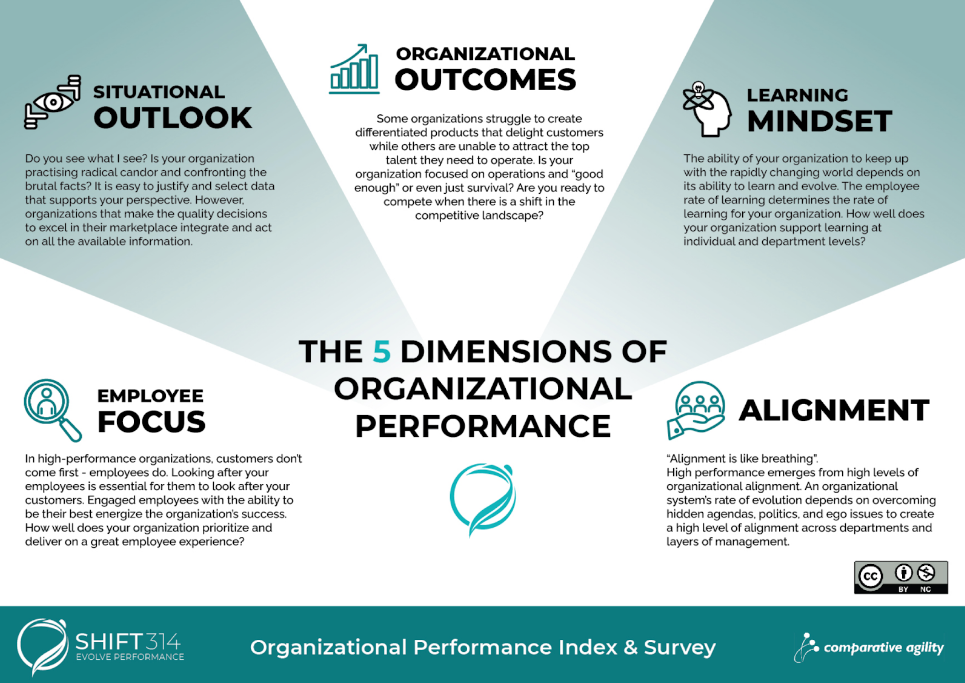Organizational success, like personal success and achievement, comes in many flavors. One organization’s definition of success is often very different from that of another organization.
For example, does success mean the company is profitable and growing? Or does success mean engaged, motivated, happy employees? Alternatively, does success mean that the CEO gets fame and recognition? Or does success mean that the company has a sustainable organization?
Ultimately, it’s up to the owners of the company, the founders, or the shareholders to decide what organizational success means and communicate that effectively.
Our Definition of Organizational Success
If you look at traditional organizations that are publicly traded on stock exchanges, their definition of success is very narrow. It’s quarterly profits that are happening now — that’s it. Their measure of success is not the long-term health, viability, share value, or survivability of an organization.

Most organizations only have a financial measure for success because it is tangible. Organizations are bound by the traditional structures of the bottom line, tasked by the shareholders and boards. This is a business-as-usual metric for success.
At SHIFT314 we use a measure of success that aligns with the organizations’ best interests. It leads to sustainable financial success created by an evolutionary way of doing business. Some high-performance organizations have demonstrated this for decades. How do organizations become successful without traditional styles of management? How are these “Teal” organizations thriving, navigating the complex business world, out performing their competition and scaling beyond comprehension?
The 5 Dimensions of Organizational Success
There are five dimensions we’ve found to be critical for organizational success:
- Employee Focus
- Situational Outlook
- Learning Mindset
- Alignment
- Organizational Outcomes
We’ll dive deeper into each one of these dimensions below.

#1 Employee Focus
Employee focus means that employees are looked after and have what they need to be successful. They’re able to collaborate and they’re supported in doing their work. There’s a saying: “You ship your team.” The state of your employees determines what your organization is able to accomplish.
Successful organizations have employees that:
- Have psychological safety, there is
- Use a collaborative work approach
- Are motivated by the organizational purpose, not compensation

This is what an Evolutionary Organization looks like. Success requires a new paradigm in leadership, management and ways of working.
#2 Situational Outlook
The next dimension is Situational Outlook. This is about whether people really see the truth of what’s happening in an organization. In many organizations, information trickles up and gets distorted as it goes through the layers of the hierarchy.
Does your organization actually operate on the truth of what’s happening in the organizational system? In business-as-usual organizations, there is a structure of metrics that give leadership an understanding of how the organization is functioning. These are things like KPIs or OKRs.
These metrics tend to spin wheels, instead of revealing the truth of processes and production. We see standard practices of under scoring, hiding real information or worse yet, management and team bonuses prescribed by the metric scores. All of this leads to misinformation. Status quo is promoted and a red tape of policy creates low engagement of staff. It also enables a management policy of hiding low performance within false information from traditional metrics.

Business as Usual = Low Performance
When an organization can see the truth of what’s happening, its leaders can make effective plans. They can make adjustments to the system to help it function better. Most organizations today are in a high level of deception, denial, and distortion of what’s actually happening day to day. This leads to a lot of interventions that actually make things worse. The metrics are used to blame the workers. The root issue of the organizational environment and a traditional style of command and control leadership is not addressed.
It’s not the metrics that are bad, it’s the way they are used and creating misinformation that supports the lack of ability to uplift an organization towards high performance.
#3 Learning Mindset
The next dimension of organizational success is a learning mindset. This refers to whether there’s space and time to focus on increasing the production capability of the system.

Production Capability means the people, the teams, eventually the entire organization is constantly learning and making improvements. This is a learning mindset – spending time understanding where and how performance can be increased.
Production vs Production Capability
One of the challenges within a traditional (low performance) organization is the focus on production. There is no room for a balanced view of the short and long term requirements for success, or future sustainability. When there is a healthy respect and investment in production capability, it creates the balance that allows the organization to be successful.
However, most traditional organizations are busy putting out fires. Their structures, processes, and staff are not equipped to function at their highest levels of performance. Traditional organizations can only focus on production, and there is no room to have a learning mindset. In fact a learning mindset cannot be introduced since it’s not a traditional business model.

Again we see spinning wheels, where nothing can be fixed or changed. When an organization understands the benefits of learning, it can then begin to integrate Production Capacity. This will help to guide an organization towards higher levels of performance.
#4 Alignment
The next dimension critical for organizational success is whether there is coherence in the organization commonly referred to as Alignment. Is there coherence between different departments so they work together effectively? Is there coherence between different layers of the management so that everyone is pulling in the same direction? Is there alignment on what is considered “done,” how teams and people communicate, and how meetings are conducted?
Alignment is critical for an organization to function. Otherwise, we’re just wasting energy through misalignments in the system. In traditional organizations there is a lack of trust, psychological safety, and support that creates misalignment. Everyone knows it’s there, yet nothing is said or done about it. Misalignment creates damage and chaos. It is the cause of the disengagement, resistance, and lack of motivation within the organization. Misalignment causes low performance.
#5 Organizational Outcomes
The final dimension is about organizational outcomes. Is the organization actually able to use its talent effectively to create products that thrive in the marketplace? Is it ready to compete head to head with new entrants and technological disruptions?

Organizational outcomes, whether they are based on financial profitability or creating extraordinary workplaces, are created by the people who work within the organization. When you understand that high performance is created by the employees you can begin to create an environment to support the success of your people.
We call this “Scaling Excellence with People.” Leaders can begin to support the brilliance of their staff, who deliver faster and better. Leaders also uplift the people and teams to develop their abilities to expand beyond the goals of the organization. All of this is dependent on having a healthy work environment for everyone to show up as their best self.
An Evolutionary Model for Organizational Success
Organizations such as Google and lesser-known ones such as MorningStar Farms have been using new ways of working to create very successful organizations. If you stop to look at how these organizations are functioning, how they run their organizations, process, structures, etc., you’ll notice that it’s not business as usual. The way these businesses are run, how they treat their employees, their culture, the processes and structures are not anything like what is taught in business schools.
For example, there are structures such as: people creating their own salaries and compensation, taking a vacation whenever you want, or autonomous work. At the organization Valve, they say “we hired you because you are smart, you figure out what work you will do.” Google was known for having free food, innovative offices, great work equipment, and open workspaces and teams.
We call organizations with these work environments Evolutionary Organizations. They take care of their employees and they have leadership teams that care about their people.
The similar patterns these organizations all have for achieving success is their culture. They all have an organizational culture based on happy, engaged, psychologically safe and motivated workers. These workers produce extraordinary products, deliver faster, and have positive engagement with their customers. They have the ability to generate positive cash flow, allowing for success both in the short and long. We call this the SHIFT314 Virtuous Cycle and is detailed in our book Leading Beyond Change.

Our model is a visual illustration of how to create a sustainable, healthy view of organizational success. It is aligned with the research on what it actually takes to create high performance. It’s not that profits have to be traded off against employee interest, they’re actually aligned.
It’s not that the short term is balanced against the long term. In fact, looking after the long term means short term success will be there. It’s not a competition for what’s most important, it’s a yes/and – all factors together having a synergistic effect.
Why Profits are NOT the Most Important Thing
Revisiting the SHIFT314 Virtuous Cycle, how can we look after both the long term and short term success of your organization? The cycle shows the employees, the customers and the profits. Don’t we have to choose? The answer is that there’s an illusion of choice.
When we focus on any one thing at the expense of others, we start to introduce an imbalance into the system. It’s like borrowing money. Let’s say this quarter a healthy amount of shareholder dividends is $3, and we say, “Wait a second, I want $4 this quarter.” What do we have to do?

We have to take the money that’s needed for building quality customer products. Or take money from the employees. This will take the system into imbalance and it’s going to cost us the next quarter and beyond.There is a ripple effect in which, by taking a system out of balance, we can create higher short-term profits. Yet, as soon as we do that, we’ve created an imbalance in our system. That creates pressure on the whole system to keep functioning.
With the SHIFT314 Virtuous Cycle there is an understanding that the employees will take care of the customers and the customers will take care of the cash. Unless we’re investing in our people and growth, the system is actually in a state of contraction.
When the system’s in balance, all the needs are looked after and grow in their ability to function. We’re balancing the short term and the long term success of the organization.
It doesn’t actually cost an organization to treat people well. Every organization has a measurable attribute called “cash flow.” When there is a healthy use of cash flow to support a positive environment for workers, all needs are served. Happy employees create the healthy ecosystem of the Virtuous Cycle. Happy employees are created by the leadership team showing up to support people’s brilliance. The people then create the high performance needed for organizational success.

Final Thoughts
Success is optional. Most organizations are not as successful as they’d like to be. And while they say they want to improve, they are not making the daily choices that line up with that outcome. The trick to creating organizational success is to twofold. First, have clarity about what is desired. Second, have a commitment to clear away the obstacles that block success.
Business as usual does not create high performance. Organizational success depends on the performance of everyone in the organization. Organizational success starts with the people.


